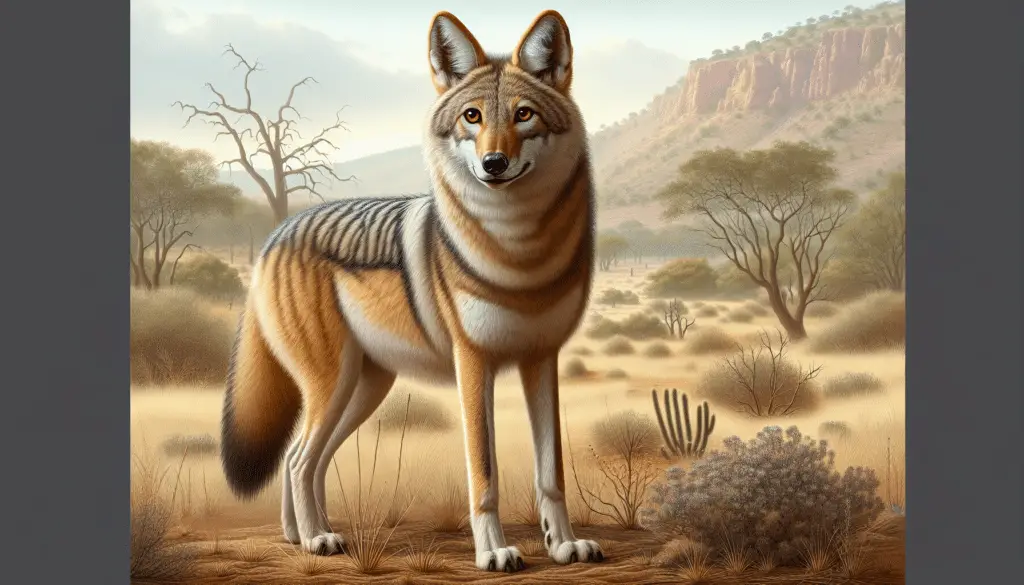Introduction to the Indian Wolf
Table of Contents
ToggleThe Indian Wolf, scientifically known as Canis lupus pallipes, is a subspecies of the gray wolf found predominantly in the Indian subcontinent.
Renowned for its distinctive physical features and fascinating behavioral traits, the Indian Wolf is smaller than its northern counterparts.
Physical Characteristics
The Indian Wolf is relatively smaller than other wolf subspecies, with an adult male averaging around 50 to 70 pounds in weight.
They typically stand 22–28 inches at the shoulder, making them more diminutive compared to their larger cousins in the Arctic and North America.
Their coats are generally shorter, which is adaptive to the warmer climates found in their habitat.
Their fur coloration ranges from grey to a reddish-brown, providing camouflage against the arid landscapes they typically inhabit.
Habitat and Distribution
The Indian Wolf is primarily found in the semi-arid and arid regions of India, Pakistan, Iran, Afghanistan, and Turkey.
They prefer grasslands, scrublands, and lightly forested areas due to the availability of prey and suitable denning spots.
Unlike other wolf subspecies that thrive in dense forests or cold tundras, Indian Wolves are well adapted to dry and hot climates.
In India, their primary habitats are the Deccan Plateau, parts of Gujarat, Rajasthan, and Madhya Pradesh.
Understanding their habitat is crucial because the Indian Wolf’s survival is closely linked to the availability of prey and human pressures in these regions.
Diet and Hunting Patterns
Indian Wolves are opportunistic feeders with a diverse diet suited to their environment.
They primarily prey on small to medium-sized ungulates such as the Chinkara (Indian Gazelle), Blackbuck, and various species of deer.
They also hunt smaller mammals like hares and rodents and, occasionally, livestock, leading to conflict with local herders.
These wolves hunt in pairs or small packs, using their keen senses and cooperative strategies to outmaneuver their prey.
One fascinating aspect of their hunting behavior is their reliance on their speed and endurance to pursue prey over long distances, often employing a strategy called “coursing.”
Breeding and Lifecycle
Indian Wolves typically mate between October and December, culminating in the birth of pups from January to March.
The gestation period lasts around 62-75 days, and a female wolf usually gives birth to a litter of 4-6 pups.
Pups are cared for in dens, which are often dug by the female in secluded, safe areas.
The mother nurtures the pups and provides food by regurgitating pre-digested meat until they are old enough to consume solid food.
By the age of six months, pups participate in minor hunts and gradually learn essential survival skills from the pack members.
Behavior and Social Structure
Indian Wolves exhibit a complex social structure dominated by alpha pairs that lead and make crucial decisions for the pack.
They communicate through vocalizations, body language, and scent marking to maintain pack cohesion and territory boundaries.
Their territories can span hundreds of square miles, depending on prey availability and the extent of human encroachment.
Packs usually consist of 6-8 members, but it’s not uncommon to see solitary wolves or pairs, especially during the dispersal period when juveniles leave to establish their territories.
This pack structure aids in forming strong family bonds, ensuring the survival of their offspring.
Conservation Status
Unfortunately, Indian Wolves face numerous threats, primarily from habitat loss and human-wildlife conflict.
Their tendency to prey on livestock has made them targets for local farmers and herders, leading to retaliatory killings.
Conservation efforts are hampered by a lack of awareness and inadequate legal protection in some regions where these wolves reside.
They are listed as endangered in India, with estimated populations dwindling below a few thousand.
Several conservation organizations are working diligently to protect these magnificent creatures through habitat restoration and promoting coexistence strategies between humans and wolves.
Similar Species and Differences
Indian Wolves are often compared to other subspecies like the Arabian Wolf and the Iranian Wolf.
The Arabian Wolf (Canis lupus arabs) is smaller and lives in the Arabian Peninsula’s harsh desert climates.
In contrast, the Iranian Wolf (Canis lupus pallipes) closely resembles the Indian Wolf but is found primarily in Iran and parts of Iraq.
These wolves differ primarily in size, color, and minor behavioral adaptations suited to their respective environments.
The gray wolf (Canis lupus), the broader species to which they all belong, exhibits considerable variation across its range, with adaptations that allow it to thrive in diverse habitats from arctic tundras to arid deserts.
Human Interactions and Cultural Significance
Wolves are often depicted in Indian folklore and mythology, either as cunning tricksters or noble creatures that command respect.
Their howls and elusive nature have made them symbols of both fear and admiration in various cultural narratives.
Tribal communities, especially in central India, have age-old legends that involve wolves as guardians of the forest.
Modern conflicts arise mainly due to their predation on livestock, pitting them against rural communities dependent on animal husbandry.
Efforts are being made to mitigate these conflicts through compensation schemes for livestock losses and promoting predator-friendly livestock management practices.
Challenges and Threats
The Indian Wolf faces multifaceted challenges that threaten its survival.
Habitat fragmentation resulting from urban expansion, agriculture, and deforestation severely limits their roaming and hunting grounds.
With diminishing habitats, Indian Wolves often come into contact with human settlements, leading to increased instances of human-wildlife conflict.
This heightened contact often results in wolves preying on livestock, which in turn provokes retaliatory killings by farmers and herders.
Additionally, illegal poaching for fur and body parts remains a significant threat to their population.
Conservation Strategies
Several conservation strategies have been implemented to protect the dwindling population of Indian Wolves.
One effective approach is habitat restoration, where efforts are made to preserve and rejuvenate the natural landscapes that wolves inhabit.
This includes reforestation projects and the creation of protected wildlife corridors that allow wolves to travel and hunt safely.
Education and community engagement programs are also crucial, aiming to raise awareness about the ecological importance of wolves and the benefits of coexistence.
Compensation schemes are in place in some regions to reimburse livestock losses to farmers, reducing the incentive for retaliatory killings.
Promoting predator-friendly practices, such as improved livestock management and reinforced enclosures, helps reduce conflict.
Collaborative efforts between government bodies, NGOs, and local communities are imperative for the success of these measures.
Importance of Genetic Diversity
Maintaining the genetic diversity of Indian Wolves is essential for their long-term survival.
Genetic diversity helps populations withstand diseases, adapt to changing environments, and maintain overall health.
Inbreeding, which can result from isolated populations, leads to a decrease in genetic diversity and an increase in genetic disorders.
Connecting fragmented habitats through wildlife corridors allows for gene flow between different wolf populations, preserving genetic diversity.
Conservation genetics is a crucial field that employs DNA analysis to monitor genetic health and guide conservation efforts.
Prevention of Human-Wolf Conflicts
Preventing conflicts between humans and Indian Wolves is a key aspect of conservation strategies.
Building strong, predator-proof enclosures for livestock can significantly reduce livestock losses.
Community-based predator monitoring systems can alert herders to wolf presence, allowing them to take precautionary measures.
Encouraging the use of guard animals, such as dogs, can deter wolves from approaching livestock.
Public awareness campaigns highlighting the ecological importance of wolves can change negative perceptions and foster coexistence.
Behavioral Adaptations
Indian Wolves have developed unique behavioral adaptations to thrive in their semi-arid and arid habitats.
One notable adaptation is their reliance on pack cooperation during hunts, which increases their success in capturing prey.
They also display remarkable endurance, capable of pursuing prey over long distances, often through harsh terrain.
Indian Wolves are mostly nocturnal, hunting under the cover of darkness to avoid the heat of the day and human activities.
They exhibit resourcefulness in their choice of dens, often utilizing abandoned burrows or excavating their own in secluded areas.
These adaptive behaviors contribute to their resilience in challenging environments.
Ecological Role
Indian Wolves play a vital role in maintaining the balance of ecosystems they inhabit.
As apex predators, they help regulate the populations of prey species, preventing overgrazing and ensuring vegetation health.
This regulation supports biodiversity, providing habitats for various plant and animal species.
By controlling the populations of herbivores like deer and rodents, wolves indirectly benefit the growth of plant communities.
Their presence also signifies a healthy, functioning ecosystem, as apex predators are indicators of environmental stability.
Involving Indigenous Communities
Involving indigenous communities in conservation efforts is crucial for the Indian Wolf’s survival.
Many tribal communities have coexisted with wolves for generations, possessing valuable knowledge about their behavior and habitats.
Engaging these communities in conservation planning ensures culturally sensitive and effective strategies.
Collaborative projects, such as community-led monitoring and protection programs, empower indigenous people as custodians of wildlife.
Recognizing and incorporating traditional knowledge into scientific research provides a holistic approach to conservation.
Similar Species and Comparisons
Comparing Indian Wolves to similar subspecies provides insights into their unique adaptations.
The Arabian Wolf, for example, lives in the Arabian Peninsula and is smaller with a lighter build to cope with desert conditions.
The Iranian Wolf closely resembles the Indian Wolf but tends to be slightly larger due to the different environmental conditions of Iran.
Understanding these comparisons helps appreciate the specific adaptations Indian Wolves have evolved for their habitats.
Cultural Depictions and Mythology
Wolves hold a significant place in various cultural narratives and mythologies within the Indian subcontinent.
In Indian folklore, wolves are often portrayed as both wise and cunning figures, embodying the balance of nature.
Many tribal stories depict wolves as guardians of the forest, emphasizing their role in maintaining natural order.
Understanding these cultural depictions can foster greater respect and appreciation for wolves among local communities.
FAQs
Where do Indian Wolves live?
Indian Wolves primarily live in the semi-arid and arid regions of India, Pakistan, Iran, Afghanistan, and Turkey.
What do Indian Wolves eat?
They primarily eat small to medium-sized ungulates, such as the Chinkara, Blackbuck, and various species of deer, as well as smaller mammals like hares and rodents.
How big are Indian Wolves?
Adult males average around 50 to 70 pounds in weight and typically stand 22-28 inches at the shoulder.
How often do Indian Wolves mate?
Indian Wolves mate once a year, typically between October and December.
How many pups do Indian Wolves have?
They usually give birth to a litter of 4-6 pups after a gestation period of around 62-75 days.
Are Indian Wolves endangered?
Yes, Indian Wolves are listed as endangered, with populations dwindling below a few thousand.
What are the primary threats to Indian Wolves?
The primary threats include habitat loss, human-wildlife conflict, and illegal poaching.
What is the significance of wolves in Indian culture?
Wolves are significant in Indian folklore and mythology, depicted as cunning tricksters or noble creatures that command respect.
How can one prevent human-wolf conflicts?
Using predator-proof enclosures for livestock, community-based monitoring systems, and guard animals can help prevent conflicts.
The Indian Wolf, Canis lupus pallipes, is a remarkable subspecies that has adapted to thrive in some of the most challenging environments on the Indian subcontinent.
Understanding their physical characteristics, habitat needs, dietary preferences, breeding behaviors, and social structures is essential for their conservation.
By involving indigenous communities, implementing effective conservation strategies, and fostering coexistence, we can help ensure the survival of this magnificent creature for future generations to appreciate and respect.
Their presence in the ecosystem highlights the delicate balance of nature and the importance of preserving biodiversity in our rapidly changing world.



